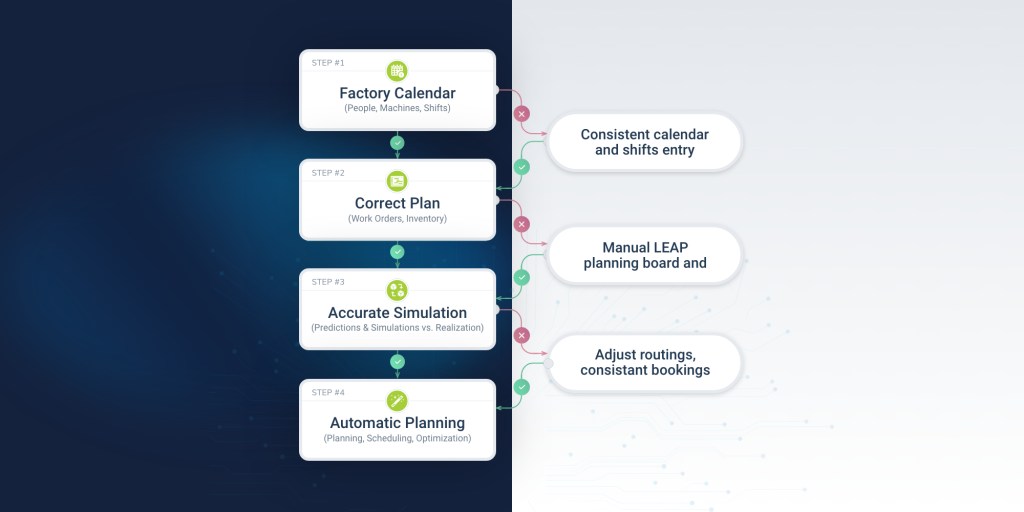Qlector Research (Jun–Sep 2025)
Qlector interviewed several of Slovenia’s largest, high-performing manufacturing companies between June and September this year. We wanted to understand their day-to-day approach to production planning, what the real challenges are, how they are solved, and what they intend to invest in next. The results are relevant to plant and operations leaders responsible for OTD, WIP, and cost control.
ERP Everywhere, MES Common, MRP Universal
Every company in the sample runs an ERP backbone. Solutions range from HTS Solution and in-house platforms to programs to roll out SAP S/4HANA at multiple sites. Three out of four also operate an MES layer, sometimes standalone with PLC connectivity on the lines, sometimes as part of the ERP estate, at least partially. MRP is universal across the board. None of that will surprise plant managers, but it matters: decisions about planning tools do not start from a greenfield site.
Planning Gap: 50% Still Depend on Excel and Paper
Every company surveyed plans in ERP; about half explicitly reference SAP APO. At the same time, 50% of companies still use manual methods such as Excel spreadsheets or paper-based planning as additional support to their ERP system. In most cases, Excel is used for shift-level micro-scheduling or annual plans.
Inefficient Planning Generates Substantial Costs
This hybrid approach continues to characterize planning processes in many factories, even though manual planning tools lack real-time visibility, rely on individual expertise, are prone to errors, and cannot quickly adapt to real-time changes.
While such methods may appear adequate in some cases, inefficient planning processes often generate substantial hidden costs, estimated in many manufacturing companies at 5–10% of annual revenue.
Efficiency Is Crucial, but Mostly Rated as Average
Here is the paradox: planning is rated as very important or critical by all respondents, yet only 25% consider their planning processes very efficient. The remaining 75% describe them as average. For executives, this gap represents a clear opportunity: planning is central to business performance, but most teams acknowledge that it could operate much more effectively.
Pain Points: Volatility, Micro-Scheduling, and Machine Sequencing
When asked where the main challenges lie, respondents cited a broad range of planning issues:
- Demand volatility and its impact on finished-goods inventory.
- Micro-scheduling in Excel that disrupts flow, complicates split orders, and slows operations.
- Machine sequencing that must account for highly specific production constraints without reducing throughput (for example, chemical-free paper changeovers).
KPIs: OTD Leads, WIP Follows, and the Role of In-House Metrics
The most frequently cited KPIs are OTD (measured or being introduced by approximately 50% of respondents) and WIP (around 25%). In addition, plants track a range of in-house KPIs such as plan vs. actual, worker efficiency, first-pass yield, OEE, plan accuracy, scrap, and inventory health (including sales trends vs. forecasts).
This combination of KPIs underscores a simple truth: any planning tool that cannot address both the corporate language (OTD, WIP) and the local dialect (plan adherence on Line 3, changeover losses on Press 6) is unlikely to succeed.
Investments Clustered Around Three Themes
Over the last year, investments concentrated on three areas (each mentioned by about 50% of companies): new lines to increase capacity, automation and warehousing, and QA camera systems to strengthen quality control.
Digital Planning Investments Largely Undefined
When asked whether they plan to invest in the digitalization of production planning within the next 12 months, the vast majority of companies reported that they do not have defined plans in this area.
Half of the respondents answered “don’t know.” The reasons vary: some are bound by group-level IT strategies that avoid local solutions, while others express interest in digitalization but do not yet have a concrete plan in place. A quarter of respondents answered “no,” yet emphasized that they should invest in this area.
Pilots with limited integration therefore represent a pragmatic entry point.
Repetitive Work Is Real and Quantified
When we asked planners to estimate the share of repeatable, structured steps in their daily process, answers clustered at 30–50%. Most reported daily performance tracking and morning briefings for the current or next day’s plan. For leaders focused on productivity, this represents a valuable opportunity: anything done the same way every day is a candidate for streamlining or AI assistance.
Document Load
Half of the respondents reported heavy document handling, such as emails, purchase orders, and small-order administration, especially in order management. A quarter said it is minimal because information is cleaned and structured daily. This contrast mirrors the maturity curve: plants with disciplined data hygiene spend less time shuffling PDFs and more time executing.
Where AI Would Help First
Asked for one domain where modern digital tools such as AI would help most, manufacturers converged on three fronts:
- Inventory and SKU management: daily stock monitoring and forecasting stock-out risk.
- Supply chain and quality: supplier reliability scoring, forecast vs. actual monitoring, and correlating final product quality with incoming component quality.
- Operational planning: delivery date calculation, workforce scheduling, and machine load optimization.
The Bottom Line
The current state of production planning in Slovenia’s largest, high-performing manufacturing companies is clear: ERP systems are widespread, MES solutions are common, and MRP has become standard. Yet planners still bridge critical tasks with spreadsheets, and most organizations rate planning performance as average despite its recognized importance.
The practical path forward is also clear: reinforce micro-scheduling, align metrics from plant to line, validate the gains of AI through focused pilots, and apply AI where work is repetitive and rules are known.
The outcome is disciplined, repeatable improvement in OTD and WIP without immediate capital investment.
Identify the Hidden Losses in Your Production Planning
If you would like to find out how much money your factory may be losing due to inefficient production planning and identify potential savings, we invite you to schedule a short, free consultation with our experts:












